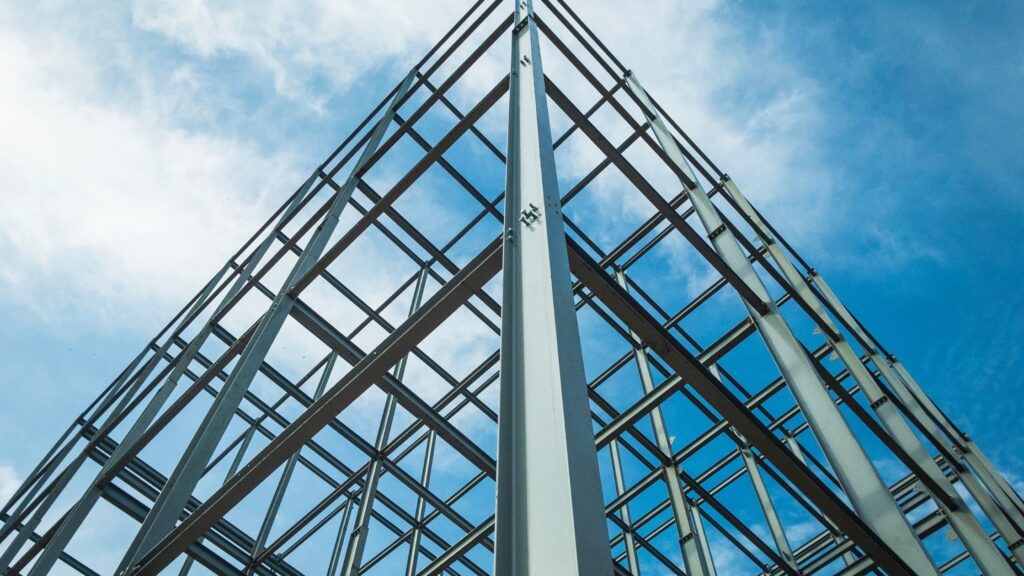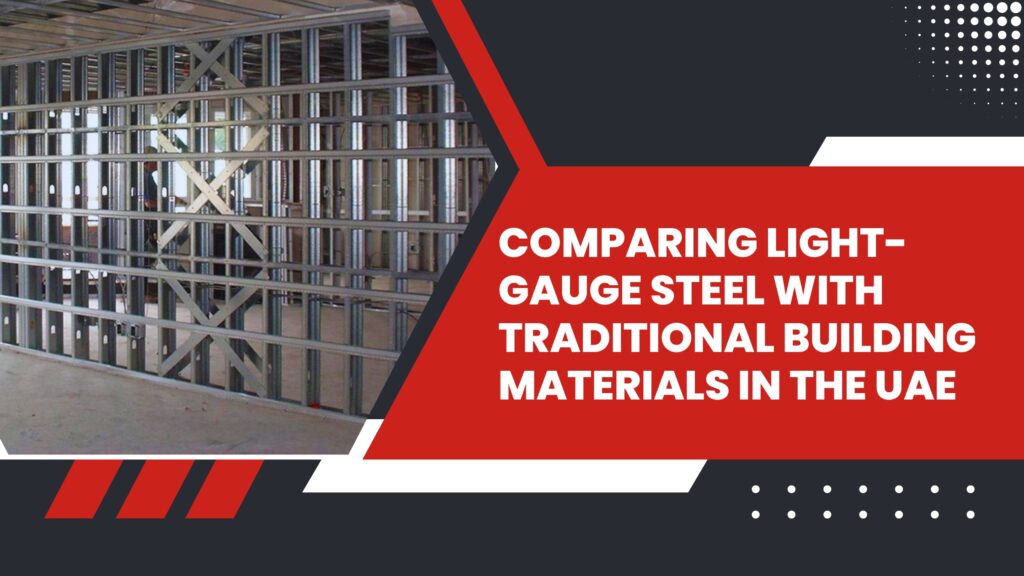Have you ever wondered what makes light gauge steel framing unique among other materials? Particularly when combined with steel framing software, light gauge steel’s exceptional durability and low weight make it perfect for framing applications.
Find out more about the benefits of using this material for your upcoming project and why builders in the field favor it.
Because it is simple to use, it simplifies the construction process and drastically lowers transportation costs. It is also among the hardest materials on the market, offering superior durability and structural integrity pound for pound.
Though many large-scale developments still primarily use conventional materials, the debate over light-gauge steel versus traditional construction in the UAE is becoming more heated. The benefits of speed, cost, and environmental impact are being considered by developers, architects, and even steel frame construction companies.
The main differences, advantages, and financial factors influencing this change are discussed in this article.
What Makes Light-Gauge Steel Different?
By carefully shaping at room temperature, cold-formed steel maintains its strength and structural integrity in contrast to hot-rolled steel, which is shaped while molten.
The final members are usually 1-2 mm thick for non-structural framing and 1-3 mm thick for structural applications. Sizes frequently match typical wood measurements, like 2″x4″ and 2″x6″.
The steel is coated with zinc (galvanized) or a zinc-aluminum mixture (galvalume or zincalume) to prevent corrosion. Environmental factors determine the coating’s thickness; dry, inland UAE regions need less protection than maritime areas.
A modular steel building manufacturer in the UAE often employs the platform frame system, which is similar to that of timber framing: a skeletal frame is constructed, covered with sheeting on both sides, and then insulated.
Pre-punched sections—holes made by the factory to facilitate the routing of plumbing and electrical wiring—are commonly used by steel frame installers.

Light-Gauge Steel vs Traditional Construction in the UAE
When you want to know about the Light-gauge steel vs traditional construction in the UAE, you will have to compare the following factors. Let’s see how they differ:
- Weight and Handling: It is possible to carry each light-gauge steel component by hand. Unlike masonry and concrete construction, this does not require cranes or other heavy lifting equipment.
- Strength and Spacing: Due to steel’s greater strength, members can be spaced farther apart, roughly 600 mm (24″) as opposed to 400–500 mm (16–20″) for timber. Faster builds and fewer members are the results of this.
- Design Versatility: Any architectural shape can be accommodated by steel framing, which makes it perfect for projects involving portacabins, modular offices, and villas.
- Speed of Construction: Faster assembly is made possible by prefabricated frames, which are essential for the UAE’s time-sensitive real estate projects.
- Durability: Light-gauge steel is resistant to termite infestation, which is a prevalent issue in some coastal areas, and it does not rot, shrink, or warp like wood does.
Here is a quick comparison table for a better understanding:
Feature | Light-Gauge Steel | Traditional Materials (Concrete, Brick, Timber) |
Weight | Lightweight, reducing foundation loads | Heavy, requiring deep foundations |
Construction Speed | Rapid assembly; ideal for prefabrication | Slower, dependent on curing times and multiple trades |
Durability | Resistant to termites, rot, and fire | Timber is vulnerable to pests; concrete is prone to cracks |
Design Flexibility | Easy to achieve complex shapes and open spans | More rigid, limited modification after construction |
Sustainability | 100% recyclable; less waste | Concrete production has high carbon footprint |
Seismic Resistance | Performs well in seismic-prone designs | Concrete can crack under repeated stress |
Cost Considerations for Light-Gauge Steel in the UAE
Both initial and lifecycle costs should be taken into account when analyzing the light-gauge steel construction cost in the UAE.
Initial Costs:
- Material Prices: Perhaps a little more expensive than masonry, but competitive with reinforced concrete when labor and time savings are taken into account.
- Transportation: Logistics costs are reduced by prefabricated panels’ lighter weight and smaller size, particularly for projects in remote locations.
Lifecycle Savings:
- Reduced Maintenance: Steel that is protected from corrosion requires little maintenance over the course of decades.
- Lower Structural Repairs: There are no settling cracks like in concrete or shrinkage like in wood.
- Reduced Foundation Costs: Smaller, less costly foundations are the result of lighter weight.
Light-gauge steel can be 20% faster in build time and provide you with 15% savings on foundation work. However, these numbers might be higher as this has yet to be studied in detail.
Benefits of Light-Gauge Steel Buildings in the UAE
The following benefits of light-gauge steel buildings in the UAE are encouraging their use in a variety of industries:
- Fast Project Delivery: Perfect for fast-paced markets like Abu Dhabi and Dubai, where developers want to complete projects quickly without compromising quality.
- Consistency in Quality: Prefabricated parts from reliable producers of light-gauge steel guarantee consistency, which lowers on-site flaws.
- Adaptability: Ideal for temporary office buildings, medical facilities, and modular schools, particularly in isolated locations.
- Less Maintenance: Steel requires less maintenance over time because it is resistant to fire, pests, and corrosion (when properly treated).
- Space Efficiency: Without sacrificing structural integrity, thinner walls than masonry provide more usable floor space.
Conclusion
Across the UAE, light-gauge steel manufacturersare transforming the way projects are built—delivering faster, stronger, and more sustainable solutions.
Compared to traditional materials, light-gauge steel offers reduced weight, quicker assembly, and long-term durability, making it a smart choice for modern developments.
Companies like Emirates Porta Cabin UAE are already taking advantage of these benefits to create high-quality modular buildings for residential, commercial, and industrial needs.
With growing demand for cost-effective and efficient construction, light-gauge steel continues to stand out as the go-to option for builders and developers seeking speed, strength, and design flexibility.
FAQs
What are the key differences between light-gauge steel and traditional construction in the UAE?
Light-gauge steel offers a higher strength-to-weight ratio, corrosion resistance, and faster installation compared to traditional concrete or timber. It’s lightweight yet durable, ideal for the UAE’s climate, and enables precise prefabrication, reducing waste and on-site labor requirements.
Why choose light-gauge steel buildings over traditional construction in the UAE?
Light-gauge steel buildings are quicker to build, require less maintenance, and withstand harsh UAE weather conditions. They’re recyclable, customizable, and allow modern architectural designs while maintaining structural integrity and cost efficiency, making them an excellent alternative to traditional materials.
How much does light-gauge steel construction cost in the UAE compared to traditional materials?
While initial costs can be similar or slightly higher than traditional construction, light-gauge steel reduces long-term expenses through lower maintenance, faster project timelines, and minimal material wastage, providing overall cost-effectiveness for both residential and commercial projects in the UAE.

